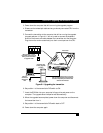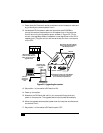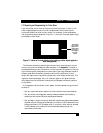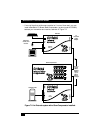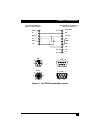
53
CHAPTER 7: Troubleshooting
7.3 Other Problems and Possible Solutions
Problem:
Poor video quality with smearing, fuzziness, or rippling.
Possible Solution:
Make sure that the video compensation has been set for your system, as described
in Sections 4.2.1 and 4.2.2.A. Check for video skew; see Section 7.2. Make sure your
Category 5 cable is pinned and paired properly; see the Appendix. Also, if you are
using cables other than those that came with the Extender to make your video
connections, make sure these are shielded or screened coaxial video cables.
Problem:
Your mouse does not move the cursor/pointer.
Possible Solutions:
1. Watch the receiver’s LED while you move the mouse. If you move the mouse
and the LED doesn’t flash, then the Extender is not receiving data from the
mouse—proceed with the next few steps.
2. Check the mouse’s connection to the receiver and the CAT5 cabling between
the receiver and transmitter; if the cable connections are OK, try removing
and restoring power to the Extender.
3. If you are attempting to connect the mouse to a PS/2 mouse port on a CPU
that has not been powered down, you will need to use the mouse-restoration
function (see Section 5.6).
4. Make sure that you have an appropriate mouse driver loaded and that your
computer’s software is configured to accept a supported mouse of the type
that you have connected. See the relevant paragraphs in Section 3.1.
5. Make sure that (a) the mouse and computer were both connected to the
Extender before any part of the system was powered up, and (b) the Extender
was powered ON before the attached computer. If you’re not sure whether
this was the case, then (if it’s possible to do so) power everything down, make
sure all cable connections are correct and secure, power up the Extender’s
receiver, then power up all attached computers.
Problem:
Your keyboard does not function or functions only intermittently. The Num Lock
LED does not always light when the Num Lock key is pressed.
Possible Solution:
Some older keyboards were designed for use with specific computers and are not
truly PC/AT or PS/2 compatible. These are not common, but if you’re having
problems like this and you’re using an old keyboard, try a newer keyboard.



